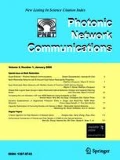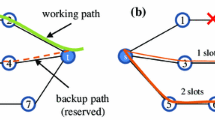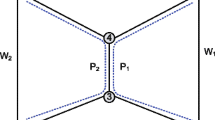Abstract
In this paper, we investigate the problem of establishing static connections with fault-tolerant requirements, also known as dependable connections, taking into account quality of transmission constraints. To the best of our knowledge, this is the first study that tackles the aforementioned problem under shared risk link group (SRLG) constraints in translucent WDM optical mesh networks where typically a set of strategically localized network nodes are equipped with regeneration capability to overcome physical-layer impairment effects. A novel cross-layer heuristic approach is introduced to solve the problem for an heterogeneous networked scenario relying on a cost-effective two-stage protection procedure which combines the well-known path protection and partial path protection schemes in order to ensure instantaneous recovery from any SRLG-failure event. The proposed heuristic integrates a generic auxiliary graph model that incorporates various network heterogeneity factors such as the number of transceivers at each network node, the number of wavelengths on each fiber link, and the regeneration capability of each node, represented by different edges in the constructed graph. Moreover, the integrated auxiliary graph can be applied efficiently to model either single- or mixed-line-rate translucent WDM optical networks wherein different modulation formats are employed in order to support the transmission at different line rates. Our solution approach aims at maximizing the total number of accommodated requests by reducing network resource consumption through the simultaneous use of the backup–backup and primary–backup multiplexing techniques. We, here, present extended versions of these two techniques that generalize the sharing concept to some other important node resources—specifically, regeneration equipments which constitute the major cost factor in optical transport networks—in addition to link resources (i.e., wavelength channels). As far as we know, this is the first attempt to deploy simultaneously generalized versions of the backup–backup and primary–backup multiplexing techniques when considering static traffic patterns without compromising the 100 % fault-recoverability guarantee. The performances of the proposed heuristic are evaluated and discussed through extensive numerical experiments carried out on different network topologies. Significant improvements are demonstrated, either in terms of network blocking performance or in terms of resource utilization efficiency, in comparison with previously proposed approaches.
















Similar content being viewed by others
References
Zhang, J., Mukherjee, B.: A review of fault management in WDM mesh networks: basic concepts and research challenges. IEEE Netw. 18(2), 41–48 (2004)
Wagner, R.E.: Evolution of optical networking. In: Lasers and Electro-Optics Society 2000 Annual Meeting, pp. 161–162 (2000)
Pedrola, O., Careglio, D., Klinkowski, M., Sole-Pareta, J., Bergman, K.: Cost feasibility analysis of translucent optical networks with shared wavelength converters. J. Opt. Commun. Netw. 5(2), 104–115 (2013)
Zhao, J., Subramaniam, S., Brandt-Pearce, M.: Intradomain and interdomain QoT-aware RWA for translucent optical networks. J. Opt. Commun. Netw. 6(6), 536–548 (2014)
Himanshi, S., Amit Kumar, G.: Protection and restoration schemes in optical networks: a comprehensive survey. Int. J. Microw. Appl. 2(1), 1–7 (2013)
He, W., Somani, A.K.: Comparison of protection mechanisms: capacity efficiency and recovery time. In: Proceedings, IEEE International Conference on Communications, pp. 2218–2223 (2007)
Xue, G., Zhang, W., Wang, T., Thulasiraman, K.: On the partial path protection scheme for WDM optical networks and polynomial time computability of primary and secondary paths. J. Ind. Manag. Optim. 3(4), 625–643 (2007)
Shao, X., Cheng, X., Yeo, Y.K., Zhou, L., Wang, Y., Bai, Y.: Performance enhancement for impairment-aware SRLG failure protection in wavelength-routed optical networks. Photonic Netw. Commun. 20(1), 1–9 (2010)
Xu, D., Xiong, Y., Qiao, C., Li, G.: Trap avoidance and protection schemes in networks with shared risk link groups. IEEE/OSA J. Lightwave Technol. 21, 2683–2693 (2003)
Yang, X., Shen, L., Ramamurthy, B.: Survivable lightpath provisioning in WDM mesh networks under shared path protection and signal quality constraints. IEEE/OSA J. Lightwave Technol. 23(4), 1556–1567 (2005)
Ouyang, Y., Zeng, Q., Wei, W.: Dynamic lightpath provisioning with signal quality guarantees in survivable translucent optical networks. Opt. Express 13(26), 10457–10468 (2005)
Zhai, Y., Pointurier, Y., Subramaniam, S., Brandt-Pearce, M.: QoS-aware RWA algorithms for path-protected DWDM networks. In: Proceedings, IEEE/OSA OFC/NFOEC, pp. 1–3 (2007)
Zang, H., Huang, R., Pan, J.: Methodologies on designing a hybrid shared-mesh-protected WDM network with sparse wavelength conversion and regeneration. In: Proceedings, SPIE, pp. 188–196 (2000)
Bakri, M., Koubàa, M., Bouallgue, A.: On the optimization of CAPEX and OPEX for the design of island-based translucent optical backbone networks. Opt. Switch. Netw. J. 13, 1–16 (2014)
Mohan, G., Murthy, C.S.R., Somani, A.K.: Efficient algorithms for routing dependable connections in WDM optical networks. IEEE/ACM Trans. Netw. 9(5), 553–566 (2001)
Algin, G.B., Enstitusu, U.B.: Dedicated path protection in mixed-line-rate optical WDM networks. In: Proceedings, IEEE Signal Processing and Communications Applications Conference (SIU), pp. 1–4 (2013)
Liu, M., Tornatore, M., Mukherjee, B.: Efficient shared subconnection protection in mixed-line-rate optical WDM networks. J. Opt. Commun. Netw. 5(11), 1227–1235 (2013)
Der-Rong, D., Chih-Wei, C.: Virtual-topology adaptation for mixed-line-rate optical WDM networks under dynamic traffic. In: International Conference on Computer Communication and Networks (ICCCN), pp. 1–6 (2014)
Ramamurthy, S., Mukherjee, B.: Survivable WDM mesh networks, part I—protection. In: IEEE INFOCOM, pp. 744–751 (1999)
Zang, H., Mukherjee, B.: Path-protection routing and wavelength-assignment (RWA) in WDM mesh networks under duct-layer constraints. IEEE/ACM Trans. Netw. 11(2), 248–258 (2003)
Sridharan, M., Somani, A., Salapaka, M.: Approaches for capacity and revenue optimization in survivable WDM networks. J. High Speed Netw. 10(2), 109–125 (2001)
Yang, X., Shen, L., Ramamurthy, B.: Maximizing resource sharing in WDM mesh networks with path-based protection and sparse OEO regeneration. In: OSA Optical Fiber Communications Conference, pp. 1–3 (2004)
Doshi, B., et al.: Optical network design and restoration. Bell Labs Tech. J. 4(1), 58–84 (1999)
Shen, L., Yang, X., Ramamurthy, B.: Shared risk link group (SRLG)-diverse path provisioning under hybrid service level agreements in wavelength-routed optical mesh networks: formulation and solution approaches. IEEE/ACM Trans. Netw. 13(1), 918–931 (2003)
Sebos, P., Yates, J., Rubenstein, D., Greenberg, A.: Effectiveness of shared risk link group auto-discovery in optical networks. In: Optical Fiber Communications Conference (2002)
Eppstein, D.: Finding the k-shortest paths. In: Proceedings, IEEE Symposium on Foundations of Computer Science, pp. 154–165 (1994)
Author information
Authors and Affiliations
Corresponding author
Rights and permissions
About this article
Cite this article
Bakri, M., Koubàa, M., Bouallègue, A. et al. On the improvement of network resource utilization efficiency for the establishment of static dependable connections in SRLG-constrained WDM translucent networks. Photon Netw Commun 31, 88–111 (2016). https://doi.org/10.1007/s11107-015-0534-y
Received:
Accepted:
Published:
Issue Date:
DOI: https://doi.org/10.1007/s11107-015-0534-y




